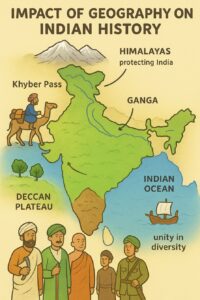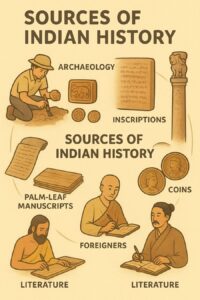2nd PUC History Question and Answer – Introduction
Looking for 2nd PUC History textbook answers? You can download Chapter 1: Introduction Questions and Answers PDF, Notes, and Summary here. 2nd PUC History solutions follow the Karnataka State Board Syllabus, making it easier for students to revise and score higher in exams.
Karnataka 2nd PUC History Textbook Answers—Reflections Chapter 1
Introduction Questions and Answers, Notes, and Summary
2nd PUC History Chapter 1
Introduction
Scroll Down to Download Introduction PDF
I. Answer the following in a word or a sentence each.
Question 1.
From which language is the word ‘India’ derived?
Answer:
The word ‘India’ is derived from the Greek language.
Question 2.
Name the work that mentions the extent of ancient Karnataka.
Answer:
The work Kavirajamarga mentions the extent of ancient Karnataka.
Question 3.
What is Numismatics?
Answer:
Numismatics is the study of coins.
Question 4.
What is excavation?
Answer:
Excavation is the scientific digging of the earth to unearth historical sources.
Question 5.
Who wrote ‘Buddhacharita’?
Answer:
Buddhacharita was written by Ashvaghosha.
Question 6.
Which is the famous work of Pliny?
Answer:
The famous work of Pliny is Natural Historia.
II. Answer the following in two words or two sentences each.
Question 1.
Name any two passes that connect India with the west.
Answer:
The Khyber Pass and the Bolan Pass connect India with the west.
Question 2.
What was the extent of India according to Vishnupurana?
Answer:
According to Vishnupurana, India lies north of the oceans and south of the Himalayas.
Question 3.
Mention any two names of India.
Answer:
Two names of India are Bharatavarsha and Jambudweepa.
Question 4.
Mention any two physical features of India.
Answer:
Two physical features of India are the Himalayas and the Northern Plains.
Question 5.
Name any two mountains of India.
Answer:
Two mountains of India are the Vindhyas and the Aravallis.
Question 6.
Mention any two dominant religions of Indian origin.
Answer:
Two dominant religions of Indian origin are Hinduism and Buddhism.
Question 7.
Mention any two World Heritage sites of India.
Answer:
Two World Heritage sites of India are the Ajanta Caves and the Taj Mahal.
Question 8.
Name any two universities of ancient India.
Answer:
Two universities of ancient India are Nalanda and Takshashila.
Question 9.
What is the extent of Karnataka according to Kavirajamarga?
Answer:
According to Kavirajamarga, Karnataka extended from the river Cauvery in the south to the river Godavari in the north.
Question 10.
Name any two important dynasties that ruled Karnataka.
Answer:
Two important dynasties that ruled Karnataka are the Chalukyas and the Rashtrakutas.
Question 11.
Write any two physical features of Karnataka.
Answer:
Two physical features of Karnataka are the coastal region and the Western Ghats.
Question 12.
‘No sources No history’. Why?
Answer:
Without sources, history cannot be reconstructed. Sources provide evidence of the past.
Question 13.
What is the difference between Pre-Historic and Historic age?
Answer:
The Pre-Historic age has no written records, while the Historic age has written records.
Question 14.
Mention any two uses of coins in the construction of history?
Answer:
Coins provide information about rulers and help to know the economic condition of the period.
Question 15.
Why are the Inscriptions the most reliable sources in the construction of history?
Answer:
Inscriptions are contemporary records, hence they are authentic and reliable.
Question 16.
What are Archaeological sources?
Answer:
Archaeological sources are the remains of past human life such as tools, coins, pottery, monuments, and inscriptions.
Question 17.
Mention the two kinds of Literary sources.
Answer:
The two kinds of literary sources are Indigenous literature and Foreign accounts.
III. Answer the following in 15 to 20 sentences each.
Question 1.
Explain briefly the impact of Geography on Indian history.
Answer:
The geography of India has greatly influenced its history, culture, and civilization. The Himalayas in the north form a natural barrier that protects India from cold winds and foreign invasions. They also give rise to perennial rivers like the Ganga, Yamuna, and Indus, which create fertile plains. These fertile plains became the cradle of ancient civilizations such as the Indus Valley Civilization and the Vedic culture. The northern passes like Khyber and Bolan, though barriers, acted as gateways for trade and also for foreign invasions.
The deserts in the west and dense forests in central India shaped the hardworking and warlike nature of the people. The Deccan Plateau and Western Ghats influenced settlement patterns and cultures in the south. The long coastline encouraged sea trade and cultural exchange with the west and southeast Asia. The geographical diversity gave rise to various races, tribes, and languages across India. Rivers and fertile valleys made India primarily an agrarian society. Minerals and stones like granite, sandstone, and marble helped in developing architecture and sculpture. Abundant rainfall and tropical climate led to rich flora and fauna. Thus, geography shaped political units, economic conditions, culture, and religion in India.
Question 2.
Explain the special features of Indian History.
Answer:
India is the seventh largest country in area and the second most populous country in the world. Even Herodotus, the Greek historian, described India as “the land of the largest population.” The history of India is unique and has several special features.
- Continuity of Civilization and Culture:
India has one of the oldest and continuous civilizations in the world, with a history of more than 4,000 years. Like China, Indian culture and traditions have continued without a break from ancient to modern times. - Evolution in Phases:
Indian civilization developed in different stages, from the Indus Valley Civilization to the Vedic period, followed by Islamic and Christian influences. Each phase contributed improvements while maintaining continuity. - Foreign Invasions:
India, especially North India, faced several foreign invasions by Greeks, Persians, Huns, Shakas, Arabs, Turks, Afghans, and others. These invaders influenced and enriched Indian culture and later merged into it. The only exception was the British, who ruled for long but did not become part of Indian culture. South India, however, developed a distinct culture as it was less affected by invasions. - Dominant and Tolerant Hindu Faith:
India is home to many religions such as Hinduism, Buddhism, Jainism, Sikhism, Islam, Christianity, Judaism, and Zoroastrianism. The Indian philosophy of Vasudhaiva Kutumbakam (“the world is one family”) and Sarve Janah Sukhino Bhavantu (“let all people be happy”) reflects the spirit of tolerance and harmony. - Contributions to the World:
India has made remarkable contributions in literature, philosophy, science, mathematics, astronomy, yoga, medicine, art, architecture, music, and dance. The concept of zero, decimal system, Ayurveda, and yoga are India’s special gifts to the world. Indian universities like Nalanda, Takshashila, and Vikramshila attracted students from abroad. More than thirty Indian monuments such as the Taj Mahal, Hampi, Ajanta, Ellora, and Konark are recognized as UNESCO World Heritage Sites. - India as a Land of Attraction:
India’s fertile land, wealth, and intellectual achievements attracted foreign traders, pilgrims, and invaders. Its scenic beauty—such as the Himalayas, Kashmir Valley, beaches, and hill stations—continues to attract tourists from across the world. - Unity in Diversity:
India has diversity in geography, race, language, religion, food, and dress, but still remains united. The Himalayas and oceans provide geographical unity, while rulers like Mauryas, Guptas, and Mughals attempted political unity. Sanskrit, Pali, Persian, English, and Hindi acted as link languages at different times. Festivals, ceremonies, and traditions foster harmony among people. In modern times, the Constitution, government policies, and globalization have further strengthened unity.
Question 3.
‘Unity in Diversity is the unique feature of Indian history’. Explain.
Answer:
India is a land of great diversity, yet unity in diversity has been its unique feature throughout history. India has diversity in geography, race, language, society, religion, and economy.
- a) Physical Diversity:
India possesses varied physical features such as the snowy Himalayas, the hot deserts of Rajasthan, the cold Siachen, fertile plains, plateaus, evergreen forests, and a long coastline. These have enriched the variety of flora and fauna. - b) Racial and Linguistic Diversity:
India is inhabited by people of different racial groups such as Dravidians, Negroids, Mongoloids, and Alpines. Linguistic diversity is also remarkable with more than 1,600 languages and dialects spoken. - c) Social and Religious Diversity:
India is a museum of religions, castes, faiths, customs, food habits, and dress styles. Hinduism, Jainism, Buddhism, and Sikhism originated in India, while Islam, Christianity, Judaism, and Zoroastrianism also co-exist here peacefully. Both patriarchal and matriarchal family systems, along with practices like monogamy, polygamy, and polyandry, have been found in Indian society. - d) Economic Diversity:
India has always had economic inequality. While some regions and cities are highly developed, others remain underdeveloped. There are both extremely rich and very poor people, as well as a sharp urban–rural contrast.
In spite of these diversities, many factors have united India:
- Geographical Unity: The Himalayas in the north and the oceans in the south form a natural boundary and a separate geographical unit.
- Administrative Unity: Rulers like Mauryas, Guptas, Chalukyas, Rashtrakutas, Mughals, and Marathas tried to establish political unity. Chanakya’s Arthashastra describes a uniform administrative system.
- Educational and Literary Unity: Sanskrit served as a lingua franca in ancient India, while Pali, Prakrit, Persian, English, and later Hindi contributed to cultural integration. Epics like Ramayana, Mahabharata, and Bhagavad Gita created a sense of oneness.
- Religious and Social Ceremonies: People of different communities participate in each other’s festivals and ceremonies, fostering harmony and brotherhood.
- Modern Changes: The Constitution, government policies, globalization, and social reforms have reduced differences and strengthened unity.
Question 4.
Write a note on the contributions of foreign writers in reconstructing the history of India.
Answer:
Foreign writers and travelers have played an important role in reconstructing Indian history. Megasthenes, the Greek ambassador, wrote Indica, which gives information about Mauryan administration and society. Ptolemy, a Greek historian, in his book Geography, described India’s trade and commercial links. The Periplus of the Erythraean Sea by a Greek author records details of coastal towns and trade. Roman writer Pliny in Natural Historia wrote about Indo-Roman relations. Chinese pilgrims also contributed valuable information. Fa-Hien in the 5th century C.E. described Gupta society and administration. Hiuen Tsang, who visited in the 7th century C.E., stayed for 18 years and wrote Siyuki, which gives a vivid account of Harshavardhana and Pulikeshi II’s reigns.
Itsing in the 7th century recorded details of Nalanda University and Buddhist practices. Muslim historians also enriched Indian history. Alberuni studied Indian society, religion, and science. Ibn Battuta, a Moroccan traveler, described the Delhi Sultanate in detail. Persian and Mughal writers like Firdausi (Shahnameh), Abul Fazl (Akbarnama), Babar (Baburnama), and Jahangir (Jahangirnama) left valuable records. Later, European travelers like Nicolo Conti, Domingo Paes, Barbosa, and Nikitin wrote about the Vijayanagara Empire. These accounts, though sometimes biased, provide first-hand information to bridge historical gaps.
Question 5.
Write a note on the importance of Archaeological sources in reconstructing the History of India.
Answer:
- Archaeological sources are the remains of past human life and activities which help us to reconstruct history, especially when written records are absent. They include objects like tools, coins, seals, inscriptions, monuments, and paintings. Excavations are very important, as they reveal prehistoric life and civilizations like the Indus Valley. Sites such as Chandragiri, Madurai, Arikamedu, Takshashila, Pataliputra, and Hampi have provided valuable information. Scientific tests like Carbon-14 dating help to fix the age of remains.
- Monuments such as forts, temples, caves, stupas, and palaces reflect the cultural and artistic heritage of India. The caves of Ajanta and Ellora, temples of Konark and Hampi, and statues of Gomateshwara and Buddha are famous examples. Coins, studied under Numismatics, give details about dynasties, economy, trade, religion, and art. The coins of Guptas, Shatavahanas, and Vijayanagara rulers are important.
- Paintings, like those in Ajanta, provide vivid pictures of dance, dress, festivals, and even historical events such as Pulikeshi II receiving the ambassador of Khusro II. Inscriptions are the most reliable sources since they are contemporary records. Ashoka’s edicts, the Hathigumpha inscription of Kharavela, the Allahabad pillar inscription of Samudragupta, and the Aihole inscription of Pulikeshi II are very valuable.
Thus, archaeological sources like excavations, monuments, coins, paintings, and inscriptions give direct and authentic information and help us reconstruct the political, social, economic, and cultural history of India.
Additional Questions and Answers
I. One Mark / One Sentence
Question 1.
Which inscription gives details about the achievements of Samudragupta?
Answer:
The Allahabad pillar inscription composed by Harisena gives details about the achievements of Samudragupta.
Question 2.
What is Epigraphy?
Answer:
The study of inscriptions is called Epigraphy.
Question 3.
Which is the earliest deciphered inscription of India?
Answer:
The Ashokan inscriptions are regarded as the earliest deciphered inscriptions of India.
Question 4.
Who composed the Iholé inscription?
Answer:
Ravikeerti composed the Iholé inscription.
Question 5.
Which university was visited by Hiuen Tsang?
Answer:
Hiuen Tsang visited Nalanda University.
II. Two Marks / Two Sentences
Question 1.
Why are coins important sources of history?
Answer:
Coins provide information about kings, dynasties, economic conditions, trade relations, metallurgy, art, and religion. They also help in dating historical events.
Question 2.
Name two foreign travelers who visited Vijayanagara Empire.
Answer:
Domingo Paes of Portugal and Abdul Razzak of Persia visited Vijayanagara.
Question 3.
What are the two main divisions of history based on sources?
Answer:
History is divided into Pre-historic period (without written records) and Historic period (with written records).
Question 4.
Mention any two inscriptions of Karnataka and their importance.
Answer:
The Halmidi inscription of Kakutsavarma and the Iholé inscription of Ravikeerti are important as they provide valuable information about Karnataka’s political history.
Question 6.
What is Numismatics? Give one example of coins in Indian history.
Answer:
The study of coins is called Numismatics. Example: Gupta gold coins.
III. Long Answer (15–20 sentences)
Question 1.
Write a note on the importance of Inscriptions in reconstructing history.
Answer:
Inscriptions are the most reliable, authentic, and direct sources of history. They are contemporary to the events, hence trustworthy. They are engraved on stones, rocks, walls, copper plates, seals, and iron pillars. More than 75,000 inscriptions have been discovered in India. They provide details about royal achievements, wars, administration, donations, land grants, and social life. For example, Ashoka’s inscriptions throw light on his administration and spread of Buddhism. The Allahabad pillar inscription written by Harisena narrates the conquests of Samudragupta.
The Hathigumpha inscription of Kharavela gives information about his expeditions. In Karnataka, the Halmidi and Iholé inscriptions provide valuable information about dynasties like Kadambas and Chalukyas. Inscriptions are also helpful in understanding the chronology of events and the development of languages. The study of inscriptions is known as Epigraphy. Thus, inscriptions are considered one of the most reliable sources for reconstructing ancient Indian history.


